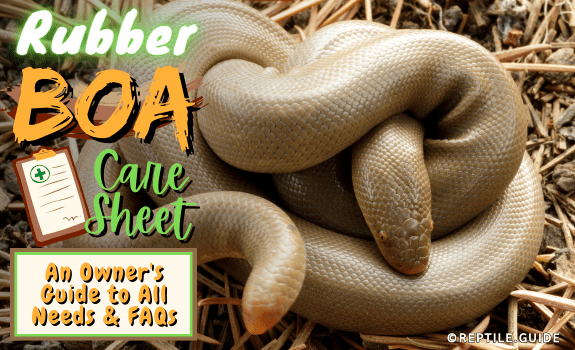The rubber boa, Charina bottae, is a medium-sized, non-venomous snake with a peaceful temperament.
Its calm, laid-back approach to life and relatively small size make it an excellent pet, even for beginner keepers.
This is also the northernmost species of boa found in the Americas. Let’s take a closer look at the rubber boa and its care needs.
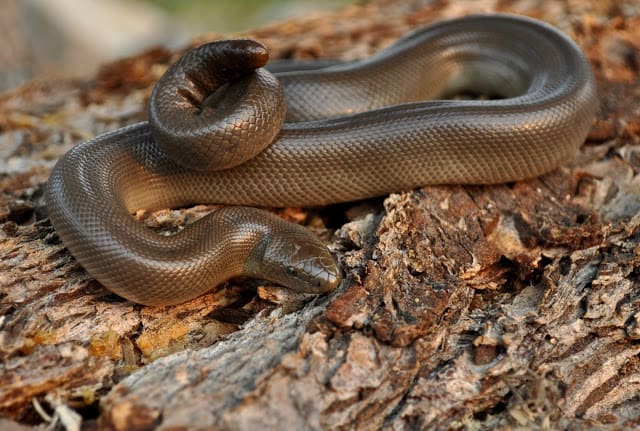
Image credit: u/lampropeltis13 (via Reddit.com)
In This Article
Northern Rubber Boa Background Information
The northern rubber boa is one of two species in the genus Charina.
Both species are residents of North America, but northern rubber boas have a more northerly distribution that reaches as far as British Columbia (and its coastal islands).
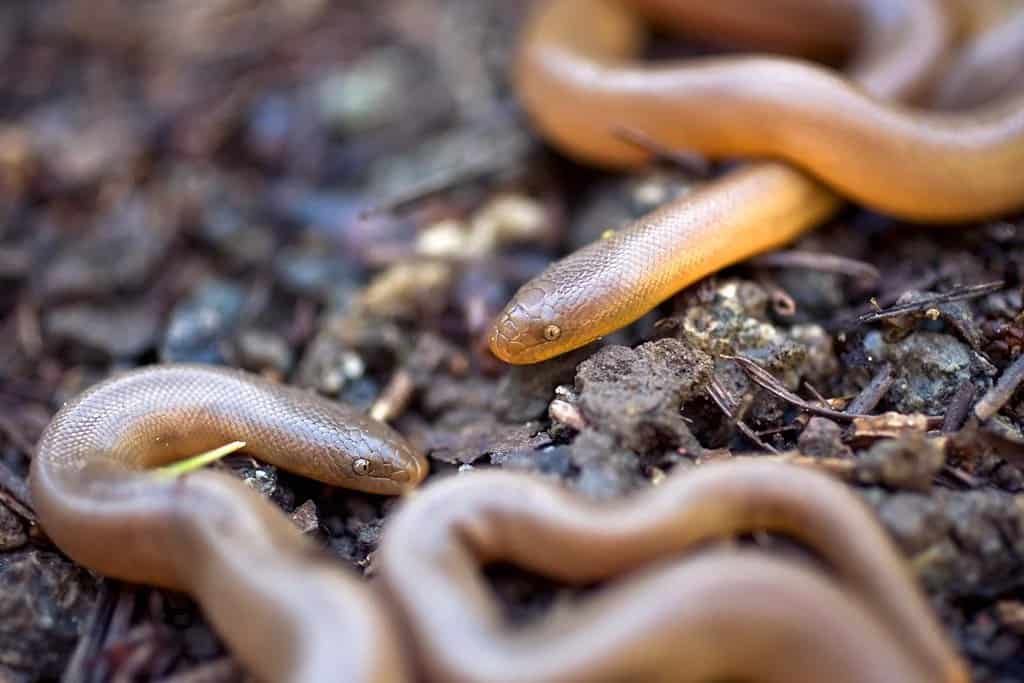
Image credit: u/zantopper
There are documented sightings of these snakes through most of the Western United States.
Some of the areas with rubber boa populations include:
- Nevada
- Montana
- Wyoming
- California
- Washington
- Western Utah
- Western Oregon
- Western Montana
- Southern British Columbia
This species inhabits a wide range of habitats which include altitudes ranging from sea level to over 8,000 feet.
What’s interesting about the rubber boa is that it doesn’t seem to have a preferred habitat type.
You can find the species in the sagebrush habitats of dry desert and even in heavy rainfall areas in other parts of the country.
What Does a Rubber Boa Look Like?
Rubber boas resemble blind snakes in many ways.
Most snakes of this species range in color from tan to dark brown.
Their bellies are lighter in color, with yellowish-brown and orange being the most common.
They have short blunt heads which don’t look at all like the sharp noses that you see in most pythons and constrictors.
Rubber boas are a lot rounder than most snakes, which adds to their unique appearance.
How Big Do Rubber Boas Get?
Rubber boas are small to medium-sized boas that measure around 1.25 to 3.76 feet long.
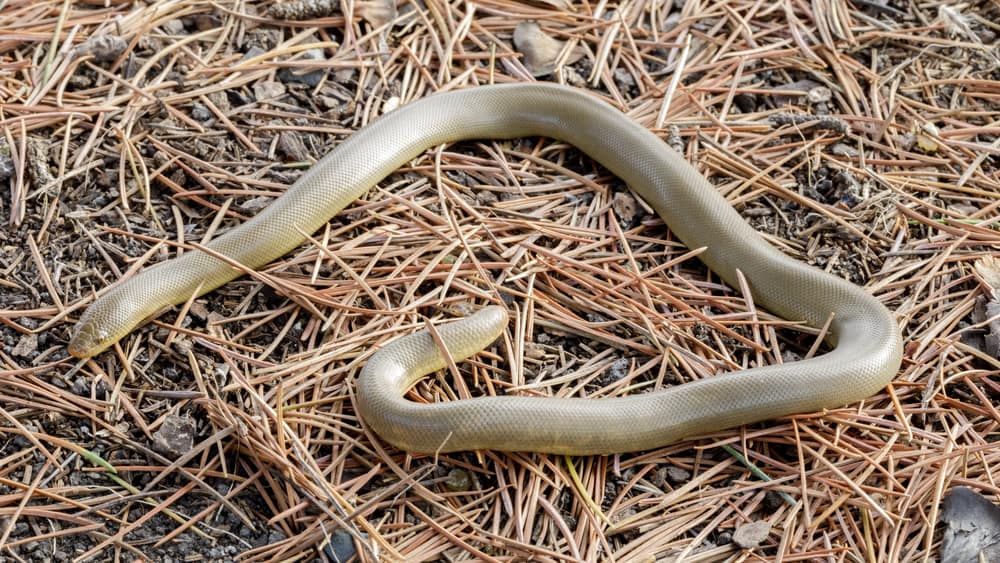
Hatchlings emerge at lengths of 7.5 to 9.1 inches long. They grow at moderate speeds and can reach maturity in three to five years.
Rubber Boa Cost of Care and Buying Price
Rubber boas aren’t the most common species in the pet trade and can be expensive (compared to common pet species like ball pythons) as a result.
You can expect to pay around $300 for a single rubber boa.
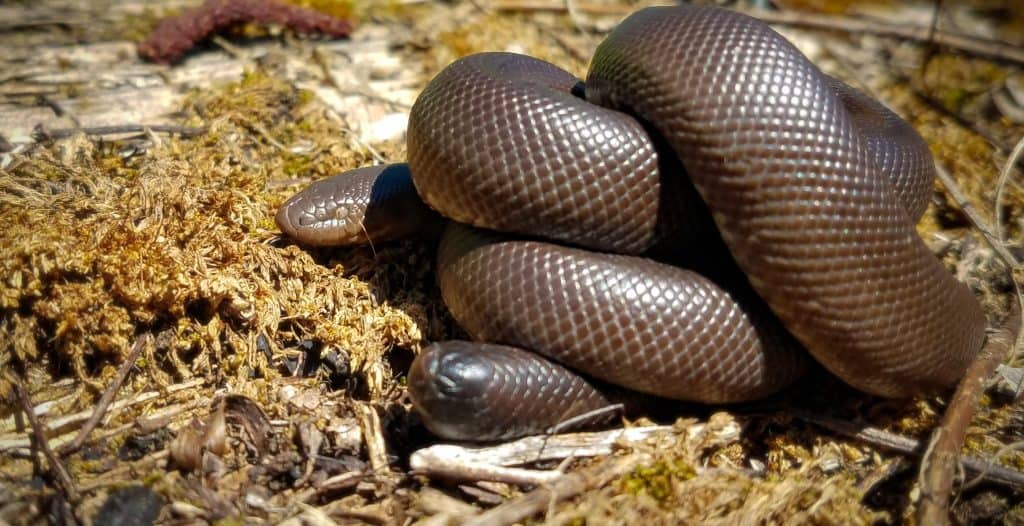
Image credit: u/newt_girl (via Reddit.com)
One of the reasons for their moderately-high price is that several states have declared it illegal to breed a rubber boa once you take it into captivity.
We’re not sure what the motivation is behind these laws but they’re probably meant to protect wild snakes.
If someone were to release captive-bred offspring into the wild, it could harm the natural gene pool of the rubber boas.
While we understand the reasoning, it makes it hard for reptile enthusiasts to secure a trustworthy source of rubber boas.
In several states, it’s legal to collect a young rubber boa from the wild, as long as you have the appropriate permits.
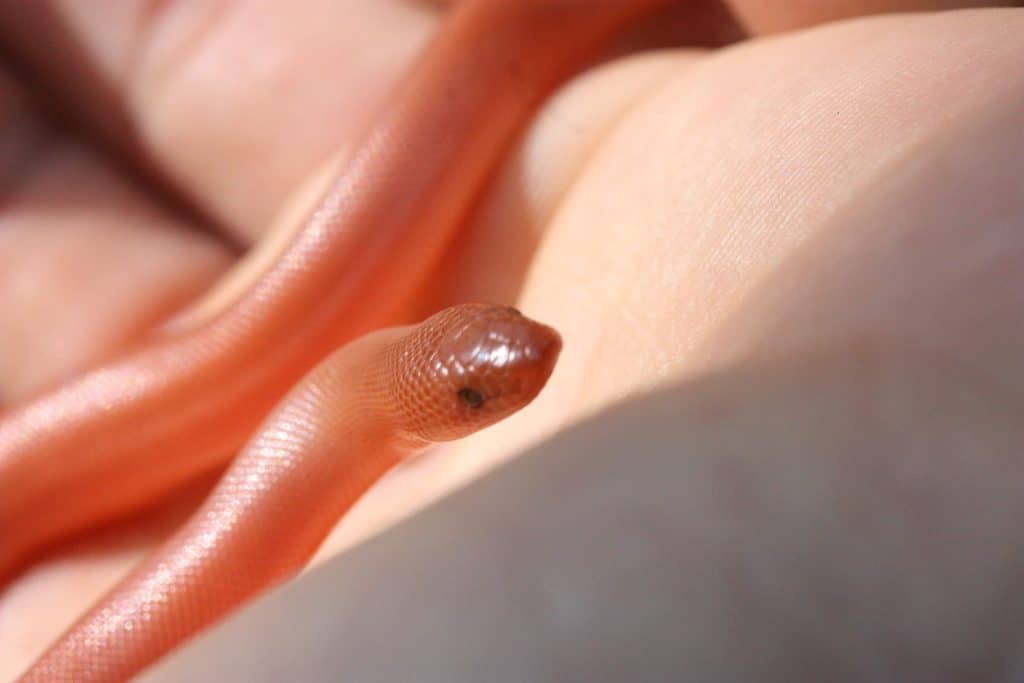
Image credit: u/panarthropodism (via Reddit.com)
That’s an option worth considering if you live in its native range, and are willing to go through the effort involved in deworming the young boa and ensuring that it’s healthy.
We recommend getting yourself onto the waiting list for one of the trusted rubber boa breeders.
Captive breeding is more sustainable and helps protect the wild population.
Costs Involved When Caring for a Rubber Boa
Fortunately, whether bred in captivity or wild-caught, this snake species isn’t expensive to keep, so you won’t need to fork out much to keep your new snake.
Let’s take apart the needs of rubber boas and see what you’ll be spending on.
Once-off costs include:
- Heat lamp – $30
- Two hides – $12
- Heating pad – $16
- Feeding tongs – $9
- Watering bowl – $10
- Two thermometer hygrometer combos – $29
- 40-gallon tank (for a full-grown adult rubber boa) – $275
That comes to a total equipment start-up cost of around $381.
Of course, these numbers are averages and estimates. It’s possible to shave down on these numbers by shopping around or even buying a pre-loved enclosure.
A rubber boa hatchling requires a much smaller enclosure than an adult, and a new 10-gallon aquarium only costs around $75, which is a saving of $200 if you’re starting small.
As with most new pets, you’ll spend the most on your rubber boa during the setup phase. You’ll use most of that equipment for the duration of your snake’s lifespan.
Of course, you also need to budget for continuous needs. There are certain things that your snake will need repeatedly:
- Full-spectrum light bulb (once every six months) – $29 each X two a year = $58 a year
- Substrate (around one pack every two weeks) – $30 each X 24 each year = $720 a year
- Food (Four mice/rats a month for juvenile rubber boas, two for adults) – $1 each X 48 a year = $48
If you use these estimations as a starting point, it would cost you around $826 a year to care for your rubber boa.
However, feeding costs diminish as the snake grows, and you might be able to buy more affordable brands locally.
So let’s put it in a nutshell:
- Yearly care costs: $826
- Hatchling rubber boa: $300
- Thermostat (optional but recommended): $19
- Startup Costs: $181 for a juvenile or $381 for an adult
- Total costs for setup and first year of rubber boa care: $1,526
When you consider that you can find cheaper, yet good-quality, versions of many of these products and that there are many ways to save costs, you can spend much less.
If you don’t mind using plastic housing, you can probably pay under $10 for housing. You can also breed rats and mice and sell the extras to help offset costs.
In short, if costs are a serious issue, you can probably get away with as little as $1,000 for the setup and first year of care.
Rubber Boa Enclosure Setup
Setting up your rubber boa’s enclosure is easy.
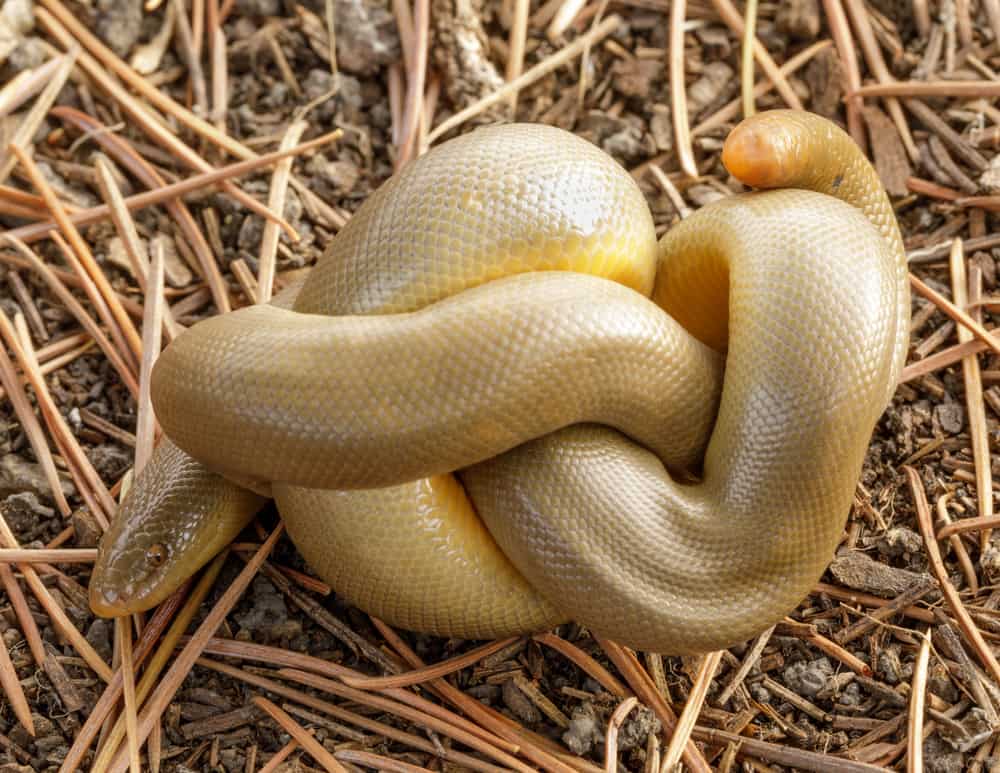
Here’s a step-by-step guide:
- Wash out the new enclosure with warm, soapy water to remove any chemical residues from the manufacturing process.
- Rinse the enclosure thoroughly to wash out any soap residue, then dry it.
- Position your heating pad where you plan to put the enclosure, ensuring that it will only cover one-half of the enclosure’s underside.
Choose a location that doesn’t get direct sunlight and that’s free of drafts. - Place your enclosure on top of the heat pad.
- Add the substrate to the enclosure.
- Position the hides, water bowl, and any decorative elements you’ve chosen for your rubber boa.
We suggest adding some sterilized branches to the tank since these snakes often climb. - Add your thermometers and hygrometer to the enclosure, and position your light to warm the hot side of the enclosure.
Remember to add the light guard so your rubber boa can’t burn itself on the bulb. - Set up the thermostat to ensure that the heating pad stays within the range (75-85 °F), and plug in all your electronic devices.
- Monitor the temperatures and ensure that the enclosure stays within the snake’s optimal range.
Most heat lamps come with manufacturer specs for positioning so that you know how high to position them to get the temperature you want.
However, a certain amount of tweaking is required, and now is the time to do it.
- Monitor the temperature for at least 24 hours, so you have time to tweak the thermostat temperatures and heating lamp height. Rubber boas are heat-sensitive.
- Once you’re sure that everything is working properly, add your snake and you’re done!
Substrate
Choosing the right substrate for your snake enclosure is vital.
It contributes towards:
- Maintaining humidity
- Making the enclosure easy to clean
- Giving the snake a sense of security
- Keeping the snake healthy and helping to avoid parasites
The rubber boa often inhabits the parts of the Western United States where soils are loose and it can burrow easily.
This burrowing activity is part of its natural behavior in captivity, and you need to accommodate it when choosing a substrate.
Like most species of snake with burrowing tendencies, rubber boas need a soft, loose substrate.
The rubber boa has sensitive skin, so you want to avoid anything with sharp or rough edges.
Let’s take a look at some of the best substrate options for these snakes:
- Newspaper – This substrate doesn’t allow for burrowing, nor is it good at maintaining humidity. However, it’s easy to clean and has no sharp edges. While we wouldn’t recommend using newspaper for your snake long-term, it’s excellent for newborns.
- Aspen or Pine Shavings -Aspen bedding is a favorite among rubber boa owners. It’s soft, lacks rough edges, and holds humidity well.
- The one downside to this substrate is that it can be rather expensive.
Pro Tip: Never use wood shavings from trees like cedar in your snake enclosure. Aromatic woods like cedar release gases that can be toxic to your snake.
- Coconut Coir Chips – Coco coir chips have many of the same advantages as aspen shavings. It’s soft, has smooth edges, and helps to maintain humidity in the enclosure. The price of the two substrates is comparable, and coco chips may be more expensive than aspen.
There are also a few substrates which you should avoid at all costs. These include:
- Sand – Sand is abrasive and can have a devastating effect on the rubber boa’s soft skin. It also has tiny particles which the snake can inhale. These grains of sand can cause irritation and inflammation in the boa’s respiratory system. Sand also offers a risk of impaction.
- Gravel – Gravel is simply too hard for your rubber boa. It has many rough edges which can damage your snake’s skin. It also doesn’t offer good support for maintaining humidity.
- Peat or Coconut Peat – Unlike the coconut coir chips, peat and coconut peat have minute particles. As with sand, the snake can inhale these particles, and then they’ll interfere with the snake’s breathing.
If you want to give your rubber boa the best option, we recommend buying aspen shavings.
This substrate is ideal as it allows the snake to burrow without risk of injury, helps maintain the humidity level, and it is too large for the snake to inhale.
Rubber Boa Heating and Lighting
Part of the reason why rubber boas manage such a northerly distribution is their extreme cold tolerance.
While you don’t want to keep your snakes too cool as a rule, overheating your rubber boas can be fatal.
Snakes can’t internally control their body temperatures. To keep their bodies at the optimal temperature, they must be able to move between warm and cool areas.
For this reason, it’s essential to give rubber boas a temperature gradient.
You can achieve the desired effect by heating only one side of the cage, and leaving the other side at room temperature.
Try to provide the following temperature zones for your rubber boas:
- Warm side – 75-85 °F
- Cool side – 65-70 °F
- Ambient temperature – 65-70 °F
Top Tip: Never allow temperatures in your boa’s enclosure to go over 85 °F.
Rubber boas prefer a cool habitat in the wild, and you should try to mimic this for your pet.
You can use an under-tank heating pad to provide a warm area for your pet at night, and a heat lamp to provide the desired temperature during the day.
Ensure that you have the right distance for the light, and a thermostat for the heating pad, as high temperatures can be fatal to rubber boas.
If your enclosure’s temperature reaches 90 °F for any length of time it will likely lead to a dead boa.
Rubber boas are light-sensitive and won’t appreciate it if you light their enclosures excessively.
They have no UVB requirement and will do well with a general 12-hour light cycle (12 hours with light, 12 hours without).
We recommend using a full-spectrum LED fixture for light cycling since LED lights don’t generate as much heat and rubber boas are sensitive to excessive heating.
Ensure that your heat lamp has a lamp guard when keeping this species.
Like some other snakes, rubber boas are inquisitive and can easily burn themselves while investigating the lamp.
Check regularly that none of your heating or lighting devices are putting your rubber boas in danger of overheating.
For rubber boas, perhaps even more than for other snakes, monitoring the temperature is essential.
We recommend incorporating three thermometers:
- One on the cool end
- One beneath the heat lamp/over the heating pad
- One in the center to monitor the ambient temperature
This may seem like overkill, but with temperature-sensitive species like the rubber boas, it’s necessary.
Brumation and Hibernation
Many snakes in temperate regions hibernate during the colder seasons.
Rubber boas also brumate or hibernate in the colder parts of their range. In captivity, they may choose to stop eating in the late summer or early fall.
Hibernation is when a snake’s body functions slow to an almost complete stop. Brumation is a much milder process where the snake’s metabolism slows down to a lesser degree.
In colder parts of their range, these snakes may hibernate. In warmer parts with moderate winters, they brumate. In captivity, they usually brumate.
While it isn’t necessary to brumate your rubber boas to keep them healthy, many snakes will naturally tend to this behavior.
If your snake stops eating, specifically in late summer or early fall, then it’s best to follow its instinct and cool down its habitat for the winter.
During brumation, you need to stop feeding and drop the temperature down to around 55 °F.
After the winter season, slowly bring the temperature back up to normal over the course of a week or so.
Water and Humidity
Rubber boas are more susceptible to dehydration than most snakes.
Their skin has a higher permeability, so they’re constantly losing moisture to the environment.
While they don’t require exceptionally high humidity, having low humidity will cause the snake to be susceptible to dehydration.
We recommend maintaining a humidity level of between 50 and 60 percent.
You can easily accomplish this by misting the substrate daily and providing a large flat water dish.
For these snakes, it’s important to keep the water dish full at all times. Due to its fast dehydration, the rubber boa drinks a lot.
It may also lie in its water bowl to help keep its skin hydrated or to cool down.
Rubber Boa Diet
In the wild, a rubber boa lives on a diet of small mammals (like deer mice), small birds, other snake species, and lizards.
You can keep your pet rubber boa healthy with a diet of rats and mice. This diet is easy to produce and affordable.
If you want to add more diversity to the diet of your rubber boa, consider trying feeder lizards.
Some people captive-bred lizards like house geckos and anoles to expand their snake’s diet.
Pro Tip: Never feed wild animals like deer mice to your rubber boa, even if it came from the wild. You might expose your rubber boa to parasites and diseases if you do.
Whether wild-caught or bred in captivity, rubber boas may sometimes struggle to accept lab mice at the outset.
Some hobbyists theorize that mice bred in captivity don’t smell enough like the deer mice, lizards, and other rodents that rubber boas naturally eat.
Because the food doesn’t smell like their natural prey, the boas may be reluctant to eat captive-bred mice.
If faced with a rubber boa that won’t eat pinkies, you can try the following:
- Wash the mouse thoroughly with a light, non-toxic soap to remove its scent.
- Rinse the animal under running water to ensure that no soap residue remains.
- Get some nesting material from a mouse nest and place it in the enclosure with the clean pinky on top of it.
While we certainly don’t recommend bringing material from wild animals into your rubber boa enclosure, sometimes desperate measures are needed.
Most keepers agree that, once a rubber boa has eaten a domestic mouse, it will eat them in the future.
If the snake still doesn’t find the mouse attractive, you can brain it. Use a sharp knife to stick a hole through the mouse’s head so the snake can smell the brain matter.
Are Rubber Boas Good Pets?
Rubber boas make excellent pets.
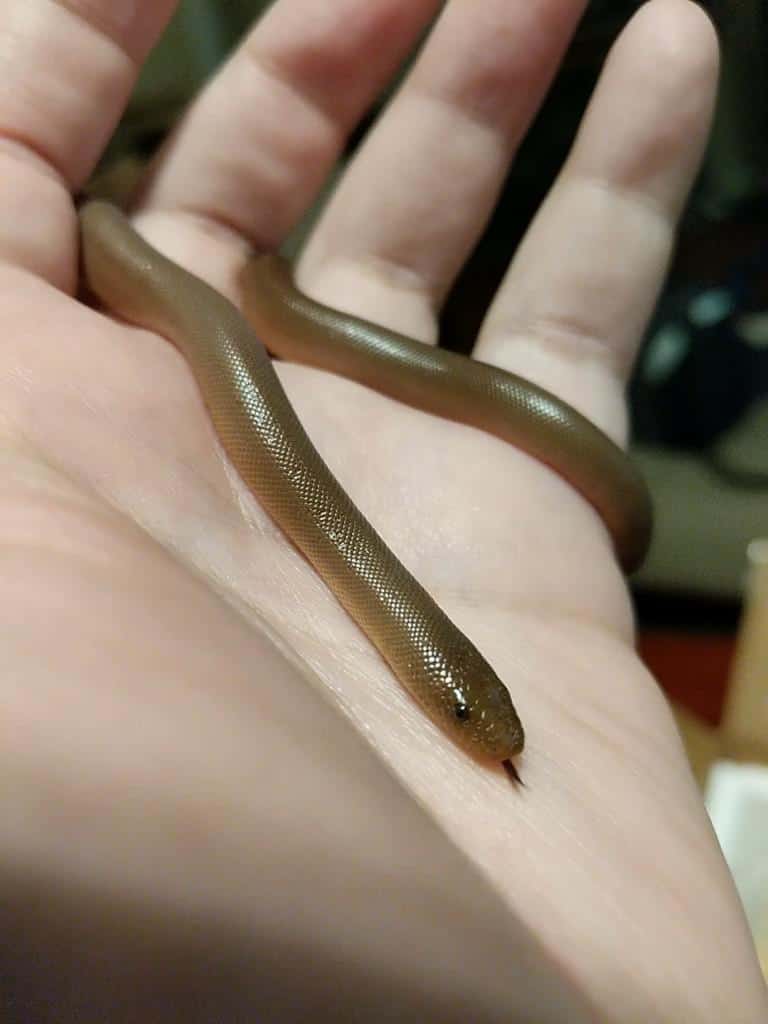
Image credit: u/LunalNalani (via Reddit.com)
They have a calmer disposition than many other species of boa, and their small size makes them easy to handle.
Rubber boas don’t often have issues with accepting food, even if they’re wild-caught, which makes them easier to keep than some other snakes.
Like most snakes, rubber boas prefer flight to bite. They’re not swift to bite, and will roll themselves into a tight ball if they feel threatened.
Unlike some other snakes in the pet trade, they’re not threatened in the wild, and keeping them doesn’t put the species at risk.
Rubber boas are one of the best boas for beginners and make an entertaining pet for more experienced hobbyists.
Is a Rubber Boa Venomous?
Rubber boas aren’t venomous.
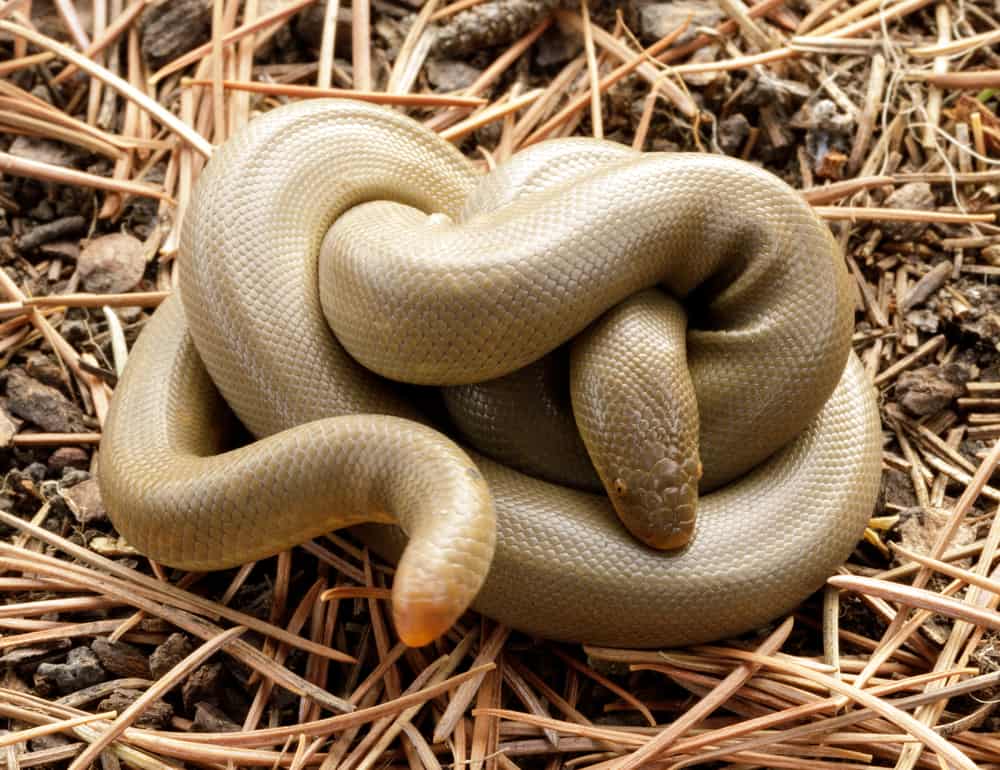
Much like its famous relative, the boa constrictor, the rubber boa doesn’t need venom.
These snake species suffocate their prey by wrapping their own body around the creature multiple times and then squeezing.
Since they don’t envenomate their prey, boas have entirely lost their venom glands.
That doesn’t mean that you might not suffer ill effects from their bite. Some people have allergies to the proteins in snake saliva.
If any type of snake bites you, it’s a good idea to get yourself checked out in case you suffer any ill effects.
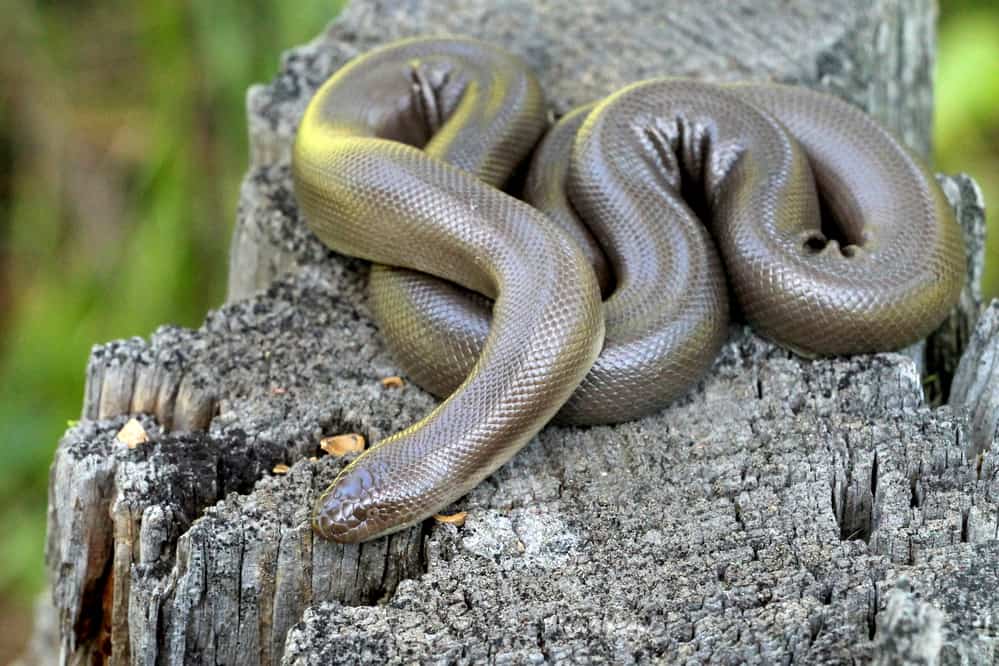
We hope you’ve enjoyed this article about rubber boas.
If you love the constrictors, and you’re still trying to choose which snake you want, check out some of our other articles about boas.
And if you’re an intermediate-level keeper, then you might find the dumeril’s boa more interesting.
Alternatively, expert keepers may find the viper boa an interesting challenge.
We’ve also written care guides for the rosy boa, Kenyan sand boa, and the Amazon tree boa.
You might also enjoy the posts about ball pythons and Brazilian rainbow boas.
Do you have a rubber boa or are you planning on getting one? Let us know in the comments.
